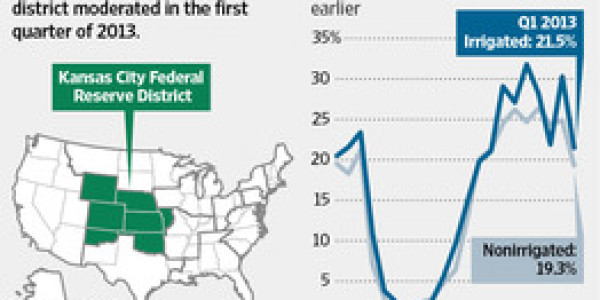By MARK PETERS The rise in prices for agricultural land slowed somewhat to start the year in parts of the U.S. Farm Belt, new reports showed, signaling a boom in land values might be moderating as commodity prices cool and incomes for farmers are expected to weaken. The Kansas City Federal Reserve Bank said in a report Wednesday that prices for nonirrigated farmland in its region rose 3.4% in the first quarter from the fourth quarter of 2012. That was much slower than the 7.7% quarter-to-quarter increase recorded for the same region a year earlier. A separate report from the St. Louis Federal Reserve Bank also released Wednesday showed that land values in parts of the Midwest and Southeast regions fell by an average of 2.3% in the first quarter compared with the previous quarter. Analysts cautioned against making too much of a single quarter. And even with those slower rates, values for nonirrigated farmland in the Kansas City district, which stretches from western Missouri to Wyoming, have soared a total of 19.3% over the past year to record levels, the bank said. More information will come on Thursday in a report expected from the Federal Reserve Bank of Chicago, whose region includes several of the biggest corn-growing states in the upper Midwest. Economists have been watching farmland values closely, with some voicing concern about a possible bubble, as farmers have plowed the money from a record run-up in commodity prices back into the land. A low interest-rate environment has exacerbated the situation, making the rising farmland more attractive for farmers seeking better returns on their money. But signs of a slowdown are emerging. The benchmark corn contract has fallen more than 20% from records set last summer as federal forecasters predict a record corn crop this autumn. Farmers’ costs also are increasing, especially for key goods such as seed and fertilizer, the Kansas City Fed said. On Wednesday, tractor maker Deere DE -4.40% & Co. forecast net cash income for U.S. farmers will fall 9.5% to $122.7 billion in 2013. But executives added that farmers should be able to withstand lower incomes because debt levels aren’t rising, even after big investments in land and equipment in recent years. “You see in the U.S. very strong farmer balance sheets, despite what’s been happening with land prices,” said Deputy Financial Officer Marie Ziegler. Nathan Kauffman, an economist with Kansas City Fed, said it will take a few quarters to determine whether the first quarter’s “modest” slowdown marks a fundamental shift in the farmland market or a short-term ebb. Bill Davis, chief credit officer at Farm Credit Services of America, said the agricultural lender saw a flurry of sales at the end of 2012 as farmers sold land ahead of tax increases that took effect this year. And while sales continue in farm states such as Iowa and Nebraska, the surge in prices hasn’t. “We have seen things level off in the first quarter,” he said. Bankers surveyed by for the Kansas City Fed’s latest report said debt levels for farmers generally remain manageable. But they noted that young farmers and those who are expanding operations face rising debt levels. The Fed bank has warned that farmers historically have increasingly turned to debt to continue capital investments even as incomes decline, which can magnify problems in a downturn. —Bob Tita contributed to this article. Write to Mark Peters at mark.peters@dowjones.com A version of this article appeared May 15, 2013, on page A2 in the U.S. edition of The Wall Street Journal, with the headline: Prices for Farmland Show Moderation. Taylor Scott International
Prices for Farmland Show Moderation

This entry was posted in Investment, investments, News, Property, Taylor Scott International, TSI, Uk and tagged article, chat, chicago, green, investment, kansas, kansas-city, moderation, news, peters, property, year. Bookmark the permalink.







